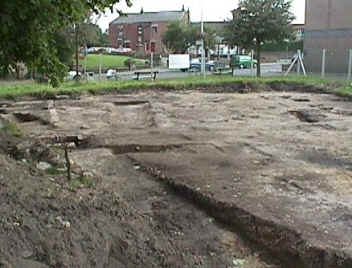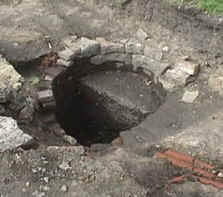Medieval Standish Revealed
|
|
Over the last few weeks a team from the Greater Manchester Archaeological Unit have
been excavating a site in the heart of Standish town centre. The work, funded by Lowry
Homes was carried out at the junction of Rectory Lane and Smalley Street adjacent to the
old Market Place, prior to the development of 32 apartments (including 29 retirement
flats). The development includes the refurbishment of the old Sunday school, which is a
grade 2 listed building built in 1829. The excavations were commissioned under the
government’s PPG16 regulations because of the site’s proximity to St
Wilfred’s Church, which is medieval in origin and mentioned as early as 1205. Stuart
Holden, the site supervisor, has sent me details of the work.
Boundary Ditch

Trial trenching found that the area to the rear of the development had been
stripped away in the 1960’s in order to build the youth club, thus removing any
archaeological remains. However, two trenches in the south-western part of the site, close
to the old Market Place, produced evidence of medieval activity. A much larger area was
therefore opened up and revealed a shallow ditch running towards the centre of the Market
Place, which contained over 25 sheers of medieval pottery dating from the 14th/15th
century. It is currently thought that this ditch, which continued to the southern edge of
the site, was a land boundary from the period separating the manorial land of the Lord of
Standish on the west and the glebe land (i.e. land belonging to the church) on the east.
Yet Another Well
 In the south-east corner of the site, a well was discovered under a concrete
capping slab. It was roughly circular in shape and built of hand made brick, which
probably dates it to no earlier than the 1700’s. It was only partially excavated to a
depth of one metre due to safety reasons, but when the contractors eventually dig it out,
before starting construction, the team will return to check if there is anything at the
bottom. An elderly local recalled to me that his parents used to use this well when the
other well, which is only across the road, was too busy. However he says the water was
never fit for drinking.
Smithy
Finally, in the western side of the study area, numerous pits were revealed which
produced ferrous waste and 19th century pottery. This suggests a small-scale industrial
activity, such as a smithy operating in the 19th century. Curiously, however, nothing is
shown on the 1st edition OS map. The excavations have finished now and these are just the
preliminary findings, but a full report has been promised when it is completed.
Next Meeting
Wednesday 6th September at the BP Centre (Scout HQ) in Greenough Street, at 7.30 pm as
usual. This month’s speaker is our very own Egyptologist John Johnson, who will be
talking about his favourite subject the pharaoh Seti I, who was the father of Rameses the
Great.
Hope to see you there - B.A.
|



